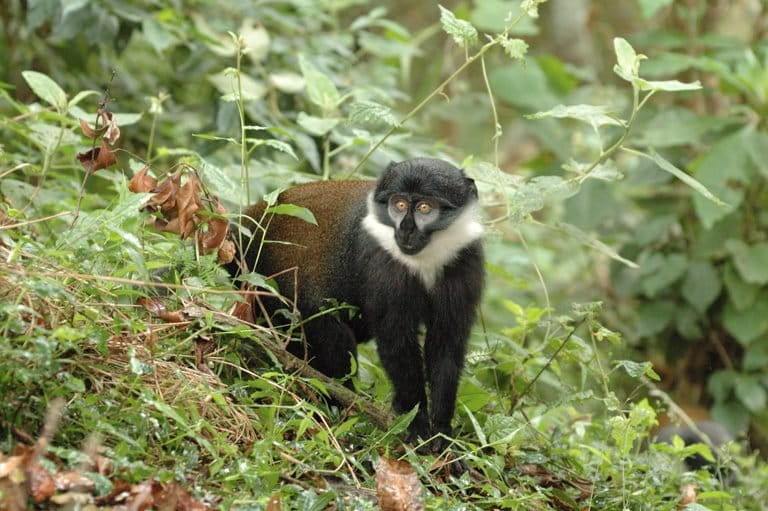- The Albertine Rift in East Africa is home to more than 500 species of plants and animals found nowhere else on the planet.
- Created by the stretching apart of tectonic plates, the unique ecosystems of the Albertine Rift are also under threat from encroaching human population and climate change.
- A new report details a plan to protect the landscapes that make up the Rift at a cost of around $21 million per year — a bargain rate, scientists argue, given the number of threatened species that could be saved.
The equatorial ecosystems of the Albertine Rift are packed with plants and animals found nowhere else on Earth. Formed as tectonic plates in eastern Africa have slowly pulled away from each other for millions of years, the unique habitats in this epicenter of biodiversity have rapidly come under threat in recent decades from conflict, poverty and a booming human population.
Now, a coalition of conservation groups is working with authorities to mobilize a plan to protect the cloud and lowland rainforests, the lakes and rivers, and the savannas and wetlands that stretch from Lake Albert south to Lake Tanganyika.

“The Albertine Rift is the most important site for vertebrate conservation in Africa, with more endemic and globally threatened vertebrates than any other region of the continent,” Andy Plumptre, a conservation biologist with the Wildlife Conservation Society’s Africa program and the paper’s lead author, said in a statement.
WCS, in concert with local NGOs and the governments of Burundi, the Democratic Republic of Congo, Rwanda, Tanzania and Uganda, has pulled together research spanning 16 years. They’ve used these investigations to better understand the six geographic landscapes selected for the high concentrations of unique and threatened species they contain, and they’ve put forth detailed plans to protect them.
According to the report, the scientists estimate that it will cost about $21 million a year to set their proposals in motion, a figure they argue “offers a greater ‘bang for the buck’ compared with other less biodiverse regions” in the world.

“We know of 163 terrestrial vertebrates that are unique to this region and we keep discovering new species,” Plumptre said. “We also know the lakes in this region have incredible fish diversity and that at least 350 species of plant are unique to the region.”
The cost per species would be about $2,500 per year, the authors write. The Albertine Rift is home to IUCN-listed Critically Endangered mountain gorillas (Gorilla gorilla beringei), Vulnerable forest elephants (Loxodonta africana) and Endangered chimpanzees (Pan troglodytes).
Of primary concern to the team is the hemorrhage of habitat throughout the region, which struggles with chart-topping population densities — in some places as high as 1,000 people per square kilometer (2,564 people per square mile). Other studies indicate that species that are endemic, meaning they only live in the Albertine Rift, or threatened with extinction have lost an average of 40 percent of their habitat.

What’s more, scientists forecast that these delicate climes created by the Rift’s striking topography are sensitive to swings in climatic conditions, potentially exacerbating the problem of shrinking habitats.
“We predict that by the end of this century, endemic species will further decline in response to climate change as many of these species will need to move to higher elevations as the climate warms,” Sam Ayebare, a conservationist with WCS in Uganda and one of the report’s authors, said in the statement. “These up-slope movements will result in a dramatic 75 percent reduction in suitable habitat.”
The report also prioritizes parts of the region for protection, particularly those that fall outside the boundaries of parks and reserves. Though the Democratic Republic of Congo recently set aside more than 10,000 square kilometers (3,861 square miles), many critical habitats, especially in the DRC, don’t have such protections, said Deo Kujirakwinja, a technical adviser with WCS in the country and a co-author of the report.
“We need to focus our attention on these sites before they, and the unique species they contain, are lost,” Kujirakwinja said.

Banner image of a mountain monkey by A.J. Plumptre/WCS.
CITATION
Plumptre, A.J., Ayebare, S., Segan, D., Watson, J. & Kujirakwinja, D. (2017) Conservation Action Plan for the Albertine Rift. Wildlife Conservation Society Report to Governments of Uganda, Rwanda, Burundi, Tanzania and Democratic Republic of Congo.
FEEDBACK: Use this form to send a message to the author of this post. If you want to post a public comment, you can do that at the bottom of the page.
